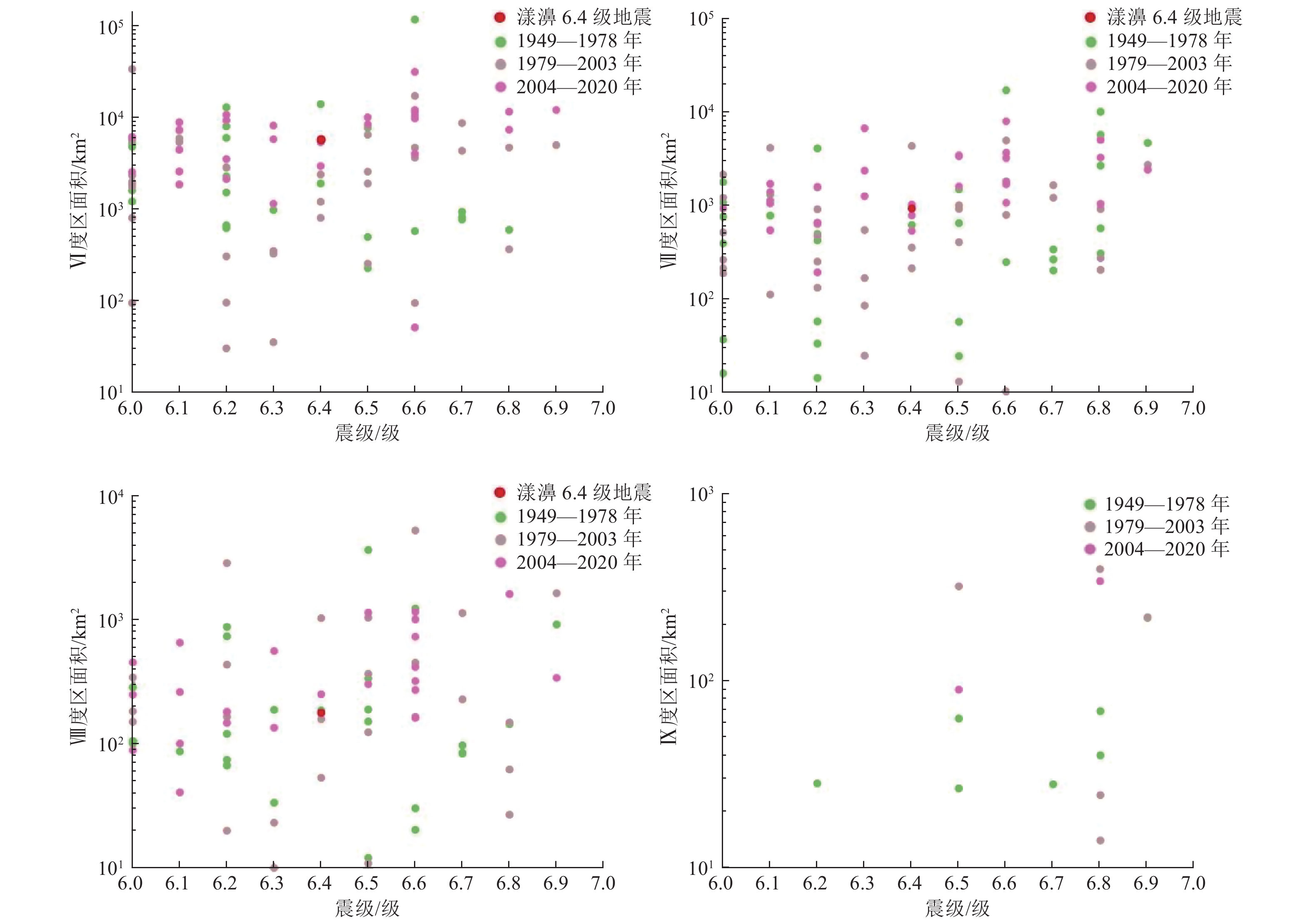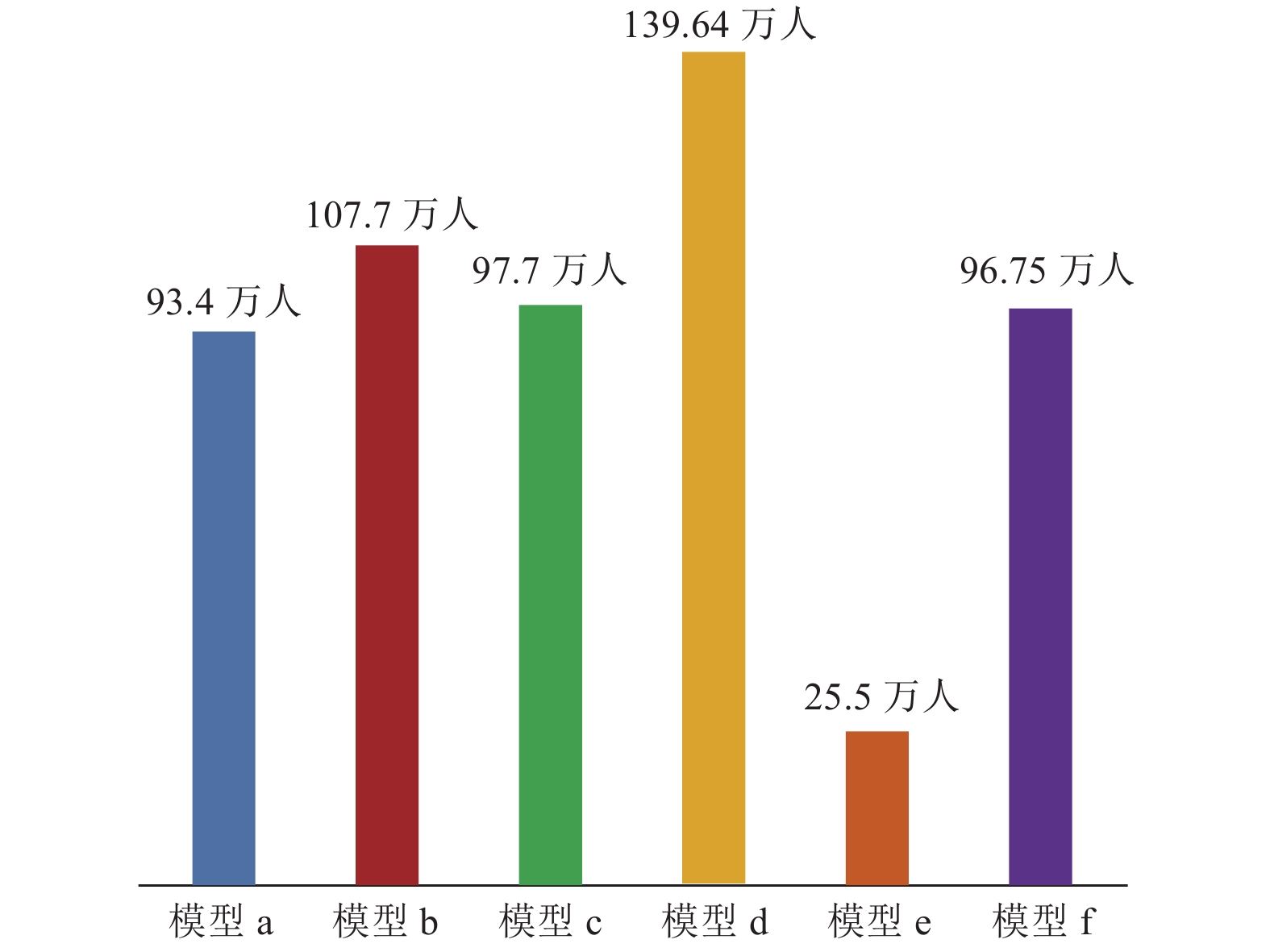May 21, 2021, Yangbi, Yunnan MS 6.4 Analysis of the Results of Rapid Assessment of Earthquake Disaster Losses
-
摘要: 本文针对2021年5月21日云南漾濞6.4级地震,选取不同的地震烈度衰减关系模型,对各模型地震影响场评估结果与发布的地震烈度图进行对比分析,并对地震影响范围不确定性进行研究。选取多种死亡人数评估模型,分别计算各模型在不同地震影响场下的死亡人数、人口分布数量,探讨各地震影响场模型下的人口分布特征及影响人员死亡的主要因素。通过对比分析可知,导致此次地震灾害损失评估结果与真实地震现场结果不同的主要原因是地震影响场分布、人口分布、房屋建筑抗震能力偏差、地形地貌、次生灾害等多种因素不同。研究结果表明,有效提高地震灾害损失快速评估精确性的途径为提高地震影响场评估精度,提高人口分布、房屋建筑等数据空间分布评估精度,后期专家检验等。Abstract: This paper selects different seismic intensity attenuation relationship models for the May 21, 2021 Yangbi M6.4 earthquake in Yunnan, and compares and analyzes the seismic impact field evaluation results of each model with the released seismic intensity map, and conducts a comparison of various intensity attenuation models. Uncertainty analysis of the earthquake impact range; select multiple casualty assessment models to calculate and analyze the number of deaths and population distribution of each death model under different earthquake impact fields, and explore the population distribution characteristics of each earthquake impact field model And the main factors affecting the casualties of the earthquake. Through comparative analysis, it can be seen that the main reasons for the difference between the loss assessment results of the Yunnan Yangbi M6.4 earthquake and the real earthquake site results are: the distribution of the earthquake affected field, the population distribution, the deviation of the estimation of the building (seismic capacity), the topography, and the frequency of the earthquake. It is caused by various factors such as natural disasters. The results show that the ways to effectively improve the accuracy of the rapid assessment of earthquake disaster losses are: improving the accuracy of the earthquake impact field assessment, improving the accuracy of the spatial distribution of data such as population distribution, housing and construction, and major factors such as later expert intervention.
-
Key words:
- Earthquake disaster loss /
- Intensity /
- Casualties /
- Population distribution /
- Assessment
-
表 1 地震现场影响场评估结果与5种地震影响场评估模型
Table 1. On-site evaluation results and five types of earthquake-influenced field evaluation models
表 2 地震现场影响场评估结果与5种影响场模型评估结果对比
Table 2. Comparison of the assessment results of the earthquake impact field between the earthquake site and the five assessment models
模型 最高
烈度Ⅵ度区/km Ⅶ度区/km Ⅷ度区/km Ⅵ度区
面积/km²Ⅶ度区
面积/km²Ⅷ度区
面积/km²长轴长度 短轴长度 长轴长度 短轴长度 长轴长度 短轴长度 a Ⅷ度 106 76 50 28 19 10 5 500 930 170 b Ⅷ度 118 82 51 29 11 5 6493 1 112 36 c Ⅷ度 119 76 51 29 11 6 5 914 1 104 43 d Ⅷ度 156 88 58 29 4 3 9 467 1 309 13 e Ⅶ度 93 54 31 16 — — 3 522 376 — f Ⅷ度 119 75 56 35 18 12 5 481 1 386 166 表 3 西南地区人口密度分组
Table 3. Population density groups in southwest China
人口密度$ \rho $/(人·km−2) b0 b1 b2 b3 相关系数R2 $ \rho < 60 $ −23.390 3.230 −0.000 030 −0.980 0.965 $ 60 \leqslant \rho < 150 $ 4.926 −0.762 0.000 300 1.559 0.980 $ \rho > 150 $ −10.485 1.763 0.000 006 −0.276 0.980 表 4 人员死亡评估模型计算结果对比
Table 4. Comparison of earthquake death assessment results of different impact field assessment models
影响场
模型最高
烈度实际死亡
人数/人刘金龙
模型/人Page P. A.模型/人 肖光先
模型/人李雯
模型/人陈棋福模型/人 a Ⅷ度 3 15 10 2 2 25 b Ⅷ度 3 15 10 1 3 25 c Ⅷ度 3 15 10 2 3 25 d Ⅷ度 3 15 10 2 8 25 e Ⅶ度 3 12 5 1 4 2 f Ⅷ度 3 15 10 2 5 25 表 5 各模型下的人口数量估算结果
Table 5. Population estimation results under each model
模型 最高
烈度Ⅵ度区
面积/km²Ⅶ度区
面积/km²Ⅷ度区
面积/km²Ⅵ度区
人口数量/万人Ⅶ度区
人口数量/万人Ⅷ度区
人口数量/万人a Ⅷ度 5 500 930 170 85.793 8 4.265 1 3.432 2 b Ⅷ度 6 493 1 112 36 99.000 0 8.500 0 0.170 0 c Ⅷ度 5 914 1 104 43 89.000 0 8.500 0 0.200 0 d Ⅷ度 9 467 1 309 13 130.000 0 9.600 0 0.040 0 e Ⅶ度 3 522 376 — 24.000 0 1.500 0 — f Ⅷ度 5 481 1 386 166 86.000 0 10.000 0 0.750 0 表 6 云南漾濞6.4级地震临震前震(M>3.0)目录
Table 6. Catalogue of imminent foreshocks (M>3.0) of the M6.4 Yangbi earthquake
序号 时间 纬度 经度 震级/级 震源深度/km 震中位置 1 2021-05-18 18:49 26.65°N 99.93°E 3.2 8 云南漾濞 2 2021-05-18 20:56 26.65°N 99.93°E 3.0 8 云南漾濞 3 2021-05-18 21:39 25.65°N 99.93°E 4.0 8 云南漾濞 4 2021-05-19 3:27 25.65°N 99.92°E 3.1 8 云南漾濞 5 2021-05-19 20:05 25.66°N 99.92°E 4.4 8 云南漾濞 6 2021-05-19 21:13 25.68°N 99.89°E 3.2 8 云南漾濞 7 2021-05-20 21:13 25.67°N 99.90°E 3.2 11 云南漾濞 8 2021-05-21 20:56 25.63°N 99.93°E 4.2 8 云南漾濞 9 2021-05-21 21:21 25.63°N 99.92°E 5.6 10 云南漾濞 10 2021-05-21 21:23 25.66°N 99.97°E 4.5 8 云南漾濞 -
[1] 白仙富, 聂高众, 戴雨芡等, 2021. 基于公里网格单元的地震滑坡人员死亡率评估模型——以2014年鲁甸Ms6.5地震为例. 地震研究, 44(1): 87—95Bai X. F. , Nie G. Z. , Dai Y. Q. , et al. , 2021. Modeling and testing earthquake-induced landslide casualty rate based on a grid in a kilometer scale: taking the 2014 Yunnan Ludian Ms6.5 earthquake as a case. Journal of Seismological Research, 44(1): 87—95. (in Chinese) [2] 陈文凯, 周中红, 张灿等, 2020. 新一代区域地震灾害快速评估系统设计与实现——以甘肃省为例. 地震工程学报, 42(6): 1683—1692 doi: 10.3969/j.issn.1000-0844.2020.06.1683Chen W. K. , Zhou Z. H. , Zhang C. , et al. , 2020. Design and implementation of a rapid assessment system for regional earthquake disasters in Gansu Province. China Earthquake Engineering Journal, 42(6): 1683—1692. (in Chinese) doi: 10.3969/j.issn.1000-0844.2020.06.1683 [3] 丁香, 王晓青, 袁小祥等, 2009.2017年5月11日新疆塔什库尔干5.5级地震生命损失评估对比分析. 震灾防御技术, 14(2): 431—437Ding X., Wang X. Q., Yuan X. X., et al., 2019. Comparative analysis of life loss assessment caused by 2017 Ms 5.5 Taxkorgan Earthquake in Xinjiang, China. Technology for Earthquake Disaster Prevention, 14(2): 431—437. (in Chinese) [4] 董曼, 程佳, 魏文薪等, 2015. 川滇分区地震烈度衰减特征研究. 震灾防御技术, 10(S1): 760—769 doi: 10.11899/zzfy2015s107Dong M. , Cheng J. , Wei W. X. , et al. , 2015. Study on zonal characteristics of seismic intensity attenuation in Sichuan-Yunnan region. Technology for Earthquake Disaster Prevention, 10(S1): 760—769. (in Chinese) doi: 10.11899/zzfy2015s107 [5] 国家地震局震灾应急救援司, 2015. 1966—1989年中国大陆地震灾害损失评估汇编. 北京: 地震出版社. [6] 李翔, 许正学, 王祥等, 2020. 广播电视地震预警技术. 广播电视网络, 27(1): 22—24. [7] 李雯, 陈文凯, 周中红等, 2019. 中国典型区域地震灾害生命易损性模型适用性评价. 北京师范大学学报(自然科学版), 55(2): 284—290Li W. , Chen W. K. , Zhou Z. H. , et al. , 2019. Assessing the applicability of life vulnerability models for earthquake disasters in typical regions of China. Journal of Beijing Normal University (Natural Science), 55(2): 284—290. (in Chinese) [8] 刘金龙, 林均岐, 2012. 基于震中烈度的地震人员死亡评估方法研究. 自然灾害学报, 21(5): 113—119Liu J. L. , Lin J. Q. , 2012. Study on assessment method for earthquake casualty based on epicentral intensity. Journal of Natural Disasters, 21(5): 113—119. (in Chinese) [9] 卢永坤, 张建国, 张方浩等, 2021.2021年云南漾濞Ms6.4地震烈度与震害特征. 地震研究, 44(3): 429—438Lu Y. K. , Zhang J. G. , Zhang F. H. , et al. , 2021. The characteristics of the seismic intensity and damage of the 2021 Yangbi, Yunnan MS6.4 earthquake. Journal of Seismological Research, 44(3): 429—438. (in Chinese) [10] 马玉宏, 谢礼立. 2000a. 地震人员死亡估算方法研究. 地震工程与工程振动, 20(4): 140—147Ma Y. H. , Xie L. L. , 2000a. Methodologies for assessment of earthquake casualty. Earthquake Engineering and Engineering Vibration, 20(4): 140—147. (in Chinese) [11] 马玉宏, 谢礼立, 2000b. 关于地震人员死亡因素的探讨. 自然灾害学报, 9(3): 84—90Ma Y. H. , Xie L. L. , 2000b. A study on factors influencing earthquake casualties. Journal of Natural Disasters, 9(3): 84—90. (in Chinese) [12] 亓凤娇, 苏鹤军, 陈文凯等, 2021. 地震灾害人员死亡评估模型对比——以甘肃省中强震为例. 华北地震科学, 39(1): 9—16, 22Qi F. J. , Su H. J. , Chen W. K. , et al. , 2021. Comparison of evaluation models of casualties in earthquake disaster—taking moderate and strong earthquakes in Gansu Province as examples. North China Earthquake Sciences, 39(1): 9—16, 22. (in Chinese) [13] 任静, 阿里木江•亚力昆, 李志强等, 2020.2020年1月19日新疆伽师6.4级地震灾害损失快速评估精确性分析. 震灾防御技术, 15(2): 349—358Ren J. , Alimujiang·Yalikun, Li Z. Q. , et al. , 2020. Contrastive analysis on the accuracy of rapid assessment of earthquake disaster losses by 2020 MS6.4 Jiashi earthquake in Xinjiang China. Technology for Earthquake Disaster Prevention, 15(2): 349—358. (in Chinese) [14] 孙继浩, 帅向华, 2011. 川滇及其邻区中强地震烈度衰减关系适用性研究. 地震工程与工程振动, 31(1): 11—18Sun J. H. , Shuai X. , H. , 2011. Study on moderate-strong seismic intensity attenuation relations in Sichuan-Yunnan and its adjacent areas. Earthquake Engineering and Engineering, 31(1): 11—18. (in Chinese) [15] 田丽莉, 2012. 地震灾害人员死亡影响因素分析及人员死亡估算公式. 北京: 首都经济贸易大学. [16] 汪素云, 俞言祥, 高阿甲等. 2000. 中国分区地震动衰减关系的确定. 中国地震, 16(2): 99—106Wang S. Y., Yu. Y. X., Gao A. J., et al., 2000. Development of attenuation relations for ground motion in China. Earthquake Research in China, 16(2): 99—106. (in Chinese) [17] 吴微微, 2013. 从汶川和芦山地震浅析四川地震次生地质灾害的特点及减灾对策. 震灾防御技术, 8(4): 434—439 doi: 10.3969/j.issn.1673-5722.2013.04.011Wu W. W. , 2013. Characteristics and countermeasures of geological hazards induced in Wenchuan and Lushan earthquakes, Sichuan province. Technology for Earthquake Disaster Prevention, 8(4): 434—439. (in Chinese) doi: 10.3969/j.issn.1673-5722.2013.04.011 [18] 吴艳梅, 赵至柔, 李敏等, 2021. 基于IPTV的云南地震预警信息发布技术及在2021年云南漾濞MS6.4地震中的应用. 地震研究, 44(3): 499—506Wu Y. M. , Zhao Z. R. , Li M. , et al. , 2021. The Yunnan earthquake early warning system based on IPTV and its application in the 2021 Yangbi, Yunnan MS6.4 earthquake event. Journal of Seismological Research, 44(3): 499—506. (in Chinese) [19] 肖光先, 1991. 震后灾害损失快速评估. 灾害学, 6(4): 12—17Xiao G. X. , 1991. Rapid assessment of disaster losses in post-earthquake. Journal of Catastrophology, 6(4): 12—17. (in Chinese) [20] 肖亮, 俞言祥, 2011. 中国西部地区地震烈度衰减关系. 震灾防御技术, 6(4): 358—371 doi: 10.3969/j.issn.1673-5722.2011.04.002Xiao L. , Yu Y. X. , 2011. Earthquake intensity attenuation relationship in western China. Technology for Earthquake Disaster Prevention, 6(4): 358—371. (in Chinese) doi: 10.3969/j.issn.1673-5722.2011.04.002 [21] 杨健强, 叶阳, 卢永坤等, 2021.2021年云南漾濞MS6.4地震房屋震害与烈度评定. 地震研究, 44(3): 439—445Yang J. Q. , Ye Y. , Lu Y. K. , et al. , 2021. Damage and intensity assessment of buildings in the 2021 Yangbi, Yunnan MS6.4 earthquake area. Journal of Seismological Research, 44(3): 439—445. (in Chinese) [22] 张方浩, 蒋飞蕊, 李永强等, 2016. 云南地区地震烈度评估模型研究. 中国地震, 32(3): 511—521 doi: 10.3969/j.issn.1001-4683.2016.03.008Zhang F. H. , Jiang F. R. , Li Y. Q. , et al. , 2016. Study of the evaluation model of the earthquake influence in Yunnan. Earthquake Research in China, 32(3): 511—521. (in Chinese) doi: 10.3969/j.issn.1001-4683.2016.03.008 [23] 张莹, 郭红梅, 尹文刚等, 2017. 基于多因素的地震灾害人员死亡评估模型研究. 震灾防御技术, 12(4): 870—881 doi: 10.11899/zzfy20170415Zhang Y, Guo H. M. , Yin W. G. , et al. , 2017. Study of multiple factors-based earthquake disaster casualties evaluation model. Technology for Earthquake Disaster Prevention, 12(4): 870—881. (in Chinese) doi: 10.11899/zzfy20170415 [24] 赵至柔, 吴艳梅, 李敏等, 2021. 云南地震预警信息发布平台设计及在2021年云南漾濞MS6.4地震中的应用. 地震研究, 44(3): 507—513Zhao Z. R. , Wu Y. M. , Li M. , et al. , 2021. Design of the Yunnan earthquake early warning information release platform and its application in the 2021 Yangbi, Yunnan MS6.4 earthquake. Journal of Seismological Research, 44(3): 507—513. (in Chinese) [25] 中国地震局监测预报司, 2001. 中国大陆地震灾害损失评估汇编(1996—2000). 北京: 地震出版社, 2001. [26] 中国地震局震灾应急救援司, 2010. 2001—2005年中国大陆地震灾害损失评估汇编. 北京: 地震出版社. [27] 中国地震局震灾应急救援司, 2015. 2006—2010年中国大陆地震灾害损失评估汇编. 北京: 地震出版社. -




 下载:
下载:




